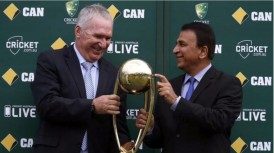Border-Gavaskar 2020/21 Series Review
Divy Tripathi |
India walked into the series without Bhuvneshwar Kumar and Ishant Sharma, they knew there wouldn’t be any Virat Kohli after the first Test and Rohit Sharma (averaging 26 abroad, yet touted as a great hope because of his extraordinary batting talent) would be available only from third test onwards. They lost Shami in the first Test, Umesh Yadav in the second, KL Rahul before the SydneyTest, Bumrah, Ashwin, Vihari and Jadeja after the epic stand-off at Sydney, Mayank Agarwal was in doubt before the final Test and Saini got injured during the fourth. Please forgive me if I missed out on a few for there were jokes on social media where the Indian side for the fourth Test might have Vikram Rathour, Ravi Shastri and Bharat Arun in the playing XI.
The playing XI for the fourth test ended up featuring three players who had stayed back as net and back-up bowlers- Washington Sundar, Shardul Thakur and T Natarajan.
They played twenty players across four tests- the most any touring team has ever featured in a Test series. Let us not even go into the personal sacrifices and commitments that many of these players missed out on while playing this Test series, just keep them in your mind while you develop a background of this series win.
It is not that the Australian side was without its challenges, Warner missed out on the first couple of games and Smith battled some indifferent form. Young talent Will Pucovski had an unfortunate time with injuries and the Australia bowling line-up seemed exhausted on the final days of the Sydney and Brisbane tests.
Still going into the third and fourth Tests, Australia would’ve been reasonably confident of doing well. For the Australian bowlers, this was the very backyard that has spawned out several great wins. Cummins, Hazelwood, Starc and Lyon are the best bowling line-up for Australia in recent times, quickly replacing the likes of Warne, Mcgrath, Gillespie, and Lee.
Smith, Labuschagne, and Warner the enforcers of Australian batting were supposed to run away with the game against India’s inexperienced bowling line-up. Tim Paine had grown into the role of the captain with his leadership in the Ashes 2019, when through astute strategy and calculated risk-taking the visitors became the first Australian side to return with the urn since 2001.
That aside the record of Australians in their own backyard is an intimidating one. I could pull out stats and state that they are amongst the toughest places to tour in the world, even though their proud record of late has been soiled due to recent losses against South Africa and India.
But that doesn’t tell the complete story. It is how Australian conditions are different from any other touring destination that makes the difference. You might give your best performance on the first three days of the test and yet end up on the losing side. First innings leads mean only so much if you have the endurance to turn up and continue fighting for every single session. It is why the Australian players well adapted to those conditions, are able to best even the most resilient of performances from visiting sides.
There is no terrible swing or turn on offer to seep doubt into your mind like in other places, but there is the feeling that even if you get in and stitch in a decent partnership, a couple of wickets here and the game might open up. Look no further than England in Adelaide 2006.
This is what makes winning in Australia all the more special. And to do that with a squad that featured only two players featuring across all four tests, with inexperience to the boot in the bowling line-up and missing one of the best batsmen in the world is a job comprehensively well done.
The team management and Indian setup in general (including the NCA, A team and U19 setup) need to take the credit for this turnaround. Every single Indian player walked in with the intent to not just do well but win the game. India might have lost the Oval Test in 2018 but its spirit is what helped them with a series win down under. There would have been no epic draw had Pant and Pujara not continued with their natural game in Sydney and gotten India closer to the target. India only decided to shut the shop after Vihari was left in a position where he found it was tough for him to stand, let alone continue with the game.
The young Siraj, Shardul, Sundar and Gill all walked in and performed as if they were veterans on a third or fourth tour down under. The old lot Pujara, Rahane, Bumrah, Ashwin and Jadeja used all their experience to best use, even putting their own well-being on the line for the team.
Then there was the small matter of Rishabh Pant. He was mocked by fans and critics alike for his mistakes on the field as a keeper (who’d often chant ‘Dhoni, Dhoni’ as if to remind him who remained the people’s favourite), even questioned by team management on occasions for his ‘repetition of mistakes’ only months after he had been India’s find of the tour in Australia (2018-19) and left out of the playing XI in the pink ball test only days after he had scored a scintillating hundred in the practice game.
Without taking away from efforts from any other player from either side: the number of runs, the tempo of innings, the fifth day pitch and the situation at which the games were poised- all indicate that the fire-and-ice approach of Pant was the difference between the two sides on the final day. If there are issues with his keeping (not saying that he can’t improve, as many of his famed predecessors did over the years) and Saha is preferred as a keeper, he has done enough to show through his sixteen-test career that he is definitely a good fit purely as a batsman.
To call it merely a sigh of relief for Indian fans for their team to figure out how to deal with the final day of a test match for back-to-back games would be incorrect. (Though many fans would admit that the ghosts of Mumbai 2006 must’ve been hanging on their minds as India were looking to bat on day 5 of the last two tests)
It was one of the greatest comebacks ever in the history of Test match cricket, definitely the greatest overseas series win for India. It wasn’t just about bouncing back from ‘36’ or winning on the final day in Gabba. It was about the fact that India were in a corner having endured an excessive number of injuries, facing abuse and tough conditions were able to beat a full-strength Australian side.
The argument that many experts brought forward before the series was that with Warner and Smith, India would find it tough to compete let alone beat Australia in Australia.
India has improved massively as a touring side with a blip between 2011-2014 but have largely been able to compete and even win abroad. However, their series wins in England, New Zealand and Australia (traditionally tough touring places for Subcontinental teams), came against teams that lacked some of their better players. India won in England against a side that missed out on services Harmison, Flintoff and Hoggard, they won against New Zealand in 2009 but that wasn’t the strongest of New Zealand teams and they won against Australia in 2018-19 without playing Warner or Smith.
This is not to take away from any of these wins, they were all brilliant wins in their own right but to put the present result in context. This win came against the side consisting of David Warner, Steve Smith, Josh Hazelwood, Marnus Labuschagne, Mitchell Starc, Nathan Lyon and Pat Cummins. Some of these players are already considered or on their way to become all-time greats for Australia.
For Australia as they plan to set out on a big tour to South Africa, the questions remain. Was it prudent to continue with the same bowling attack for all four games, despite the indifferent form of Starc and Lyon? One feels that had Australia rested a seamer for the third test and rotated players effectively after the first two games, they would’ve had fresh legs running on day 5 of the test.
The second big question for Australia will be looking for a leader going ahead. WIll they continue with Tim Paine for this important Ashes year? Chris Silverwood’s men would certainly be making plans and stratagems of their own, taking notes from Indian success as well as the Australian side of 2019 for a victory down under. It would be wise for the selectors to take a call now and build towards the next home season.
All is not lost as Australia got some good performances from Marnus Labuschagne and Pucovski, Smith returned back to what he does best, Cummins and Hazelwood were at their absolute finest and Cameron Green holds a lot of potential. If we know anything about Australia, they will be raring to go and fight back after this disappointing result. That means that we can look forward to some great cricket.
For people who value Test cricket, the big series are valued as much as some of the World tournaments in cricket. This Border Gavaskar trophy will certainly go down as one of the greatest ever series rivaling the likes of Ashes 1981, Border-Gavaskar Trophy 2001 and West Indies tour of Australia 1960-61.





Leave a comment